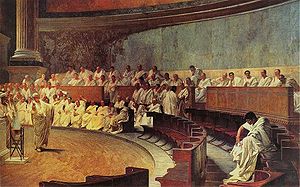- Cesare Maccari
-
Cesare Maccari Born 9 May 1840
SienaDied 7 August 1919
RomeNationality Italian Field painting
sculptingWorks Cicero Denounces Catiline Cesare Maccari (9 May 1840 - 7 August 1919) was an Italian painter and sculptor, most famous for his 1888 painting Cicerone denuncia Catalina (usually translated as Cicero Accuses Catiline or Cicero Denounces Catiline).
Contents
Biography
Maccari was a student of the "institute of the fine arts" in Siena together with Tito Sarrocchi and later worked in the atelier of Luigi Mussini in Florence. There in 1864 he was commissioned by an English society to copy works of Bernardino Pinturicchio found in the cathedral of Siena.
His works were first bought by the Marquis Pieri-Nerli who also commissioned him to paint frescoes of the four evangelists in his home in Quinciano, a hamlet in the comune of Monteroni d'Arbia.
In later life Maccari became a lecturer at the Accademia di San Luca in Rome. He became paralyzed while working on the Palace of Justice in Rome in 1909 and as a result stopped working as an artist. He died in Rome in 1919.
Works
In 1863, Maccari painted Leonardo che ritrae la Gioconda (commonly translated Leonardo [da Vinci] painting the Mona Lisa) which won an award in 1865. In his home town Siena he decorated the Sala del Risorgimento in the public palace with frescoes that were well-received by critics.
Between 1882 and 1888 Maccari painted a series of frescoes depicting Roman life at the "Sala Maccari" in the Salone d'Onore in Rome's Palazzo Madama, seat of the Italian Senate, amongst them his most famous work, Cicero Denounces Catiline.[1]
Cicerone denuncia Catalina
- See also: Catiline Orations
Maccari's most famous work of art depicts Cicero's Oratio in Catilinam Prima in Senatu Habita, his first speech denouncing Catiline in the Roman Senate which drove him from the city (63 BC). Maccari has been praised for the way his paintings captured the description of events, i.e. how Catiline has been avoided by his fellow senators and sat alone while Cicero attacked him.[2] On the other hand, his work has been criticized for some historical inaccuracy, since he depicted the Senate meeting in the wrong place — the Senate actually met in the Temple of Jupiter Stator, not in the Senate House (Curia Cornelia). Cicero was 43 years of age at the time but looks much older while Catiline, who was two years older than Cicero, looks much younger than him.[2] The painting has been reproduced in many textbooks and histories of Rome, to a point where its depiction of the Roman Senate has been influencing the presentation of the Senate of the Roman Republic in non-fiction books.[1] It is also considered the most famous painting depicting Cicero's consulship.[2]
Bibliography
- G. De Sanctis. Gli affreschi di C. Maccari nel Senato. Rome, 1889.
- G. Cantalamessa. Gli affreschi di C. Maccari nella cupola di Loreto. Rome, 1895.
References
- ^ a b Winkler, Martin M. (15 December 2006). Spartacus: film and history. Wiley-Blackwell. pp. 91. ISBN 1405131810. http://books.google.com/books?id=DeEGQQzlpcMC&printsec=frontcover&source=gbs_v2_summary_r&cad=0#v=onepage&q=&f=false.
- ^ a b c Frerichs, Karl (1 June 1997). Cicero's First Catilinarian Oration. Bolchazy-Carducci. pp. ix. ISBN 0865163413. http://books.google.com/books?id=Vh2CmEn7ar8C&printsec=frontcover&source=gbs_v2_summary_r&cad=0#v=onepage&q=&f=false.
Categories:- Italian painters
- 1840 births
- 1919 deaths
- Italian sculptors
Wikimedia Foundation. 2010.

